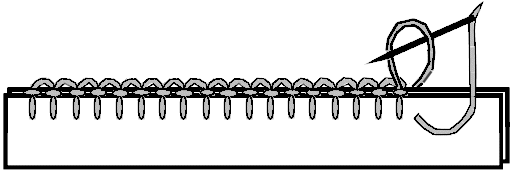| Table of Contents
|
The Sewing. There are a variety of stitches that can be used. In observing the different examples of gloves through the ages I have found the following to be used.
A Running or stab stitch is the simplest and is the most used for decorative stitching. It is in and out straight across the seam of your choice. The most common form of seam is wrong sides together. Another seam is the overlapping seam where one side is over the other.

The Whipstitch goes in the top, exits the bottom and diagonally reenters the top instead of reentering from the bottom across the seam of your choice. The most common form of seam is wrong sides together, over lapping seams, flat felled seams. With flat felled seams you would hammer the leather down to lay flat.

The round stitch is similar to the whipstitch except that you reenter the previous point you came out of. This is used for seams that are wrong sides together.

Triple stitch is two forward and one back over to lock the stitch. It can be used for most seams.

Flat stitch is forward one and one back over every stitch.

Saddle stitch uses two needles each doing a running stitch covering the space that the other stitch leaves open. This is for seams that are wrong sides together.

Knotted Blanket stitch is an over sewn seam stitch that is the most common on gloves that have decorative edges. This is for seams that are wrong side together.

Cobbler stitch is a running stitch that is completed and then restitched again covering the spaces left by the original stitch.

The Thumb. First you will want to cut the hole where your thumb will go. This will be under the pointing finger parallel to the mark you made on the sketch you made of your hand. You will need to make a line that will go from the center of the pointing finger to the bottom of the hand. This will be your center mark for the thumbhole. You will begin with sewing up the thumb and fitting it to the glove. Start at the bottom and work your half way up. At this point place the rest of the piece along what is left of the opening. If you find that you need more room clip the opening a little larger until it fits. Do the same with the other side of the thumb. Remember that this piece will be fitted like a sleeve, long side on the back of the hand and the short side on the inside of the palm. Like the arm the thumb needs more room on the side that it will be pulling away from. When you are fitting for a doublet you cross your arms to make certain you have room to move. The thumb needs this same room to move. If any cutting needs to be made, make it on the body of the glove NOT the thumb piece.
Fourchettes. Begin at the pointer finger starting at the top with these. You may want to use a wooden dowel that is shaped like a finger at one end. Place it in the fingers to help you sew up the tops of each finger. Clip any left over material. Try each finger on as you finish to assure fit. Finish each finger in the same manner trying each one on for fit. This will be your last chance to add or change anything on the fit.
Sew up the sides. Start at the top of the pinky and sew down. If your are going to be working with leather you will need to punch all your holes prior to sewing depending on the weight of the leather you chose. Glover's needles are highly recommended for heavier leathers. They are similar to epees; they have three sides that are extremely sharp. For finer leathers use fine "between" sewing needles. There is an adhesive that can aid you with keeping all the parts together while you are sewing. It is specifically made from leather hemming. It will work for this too. It is widely believed and written that adhesives were used in the aiding of leather working but they were not permanent and not meant to hold the seams together forever. You will want to work with silk thread, button twist or something similar that is just as strong. Some grades of embroiders floss will also work, ask your sales clerk for button thread strength in your floss. Regular button sewing thread will also work or canvas thread. Both of these are modern creations, an evolution of the original item, and will work just as well but they may not come in the variety of colors that silk comes in.